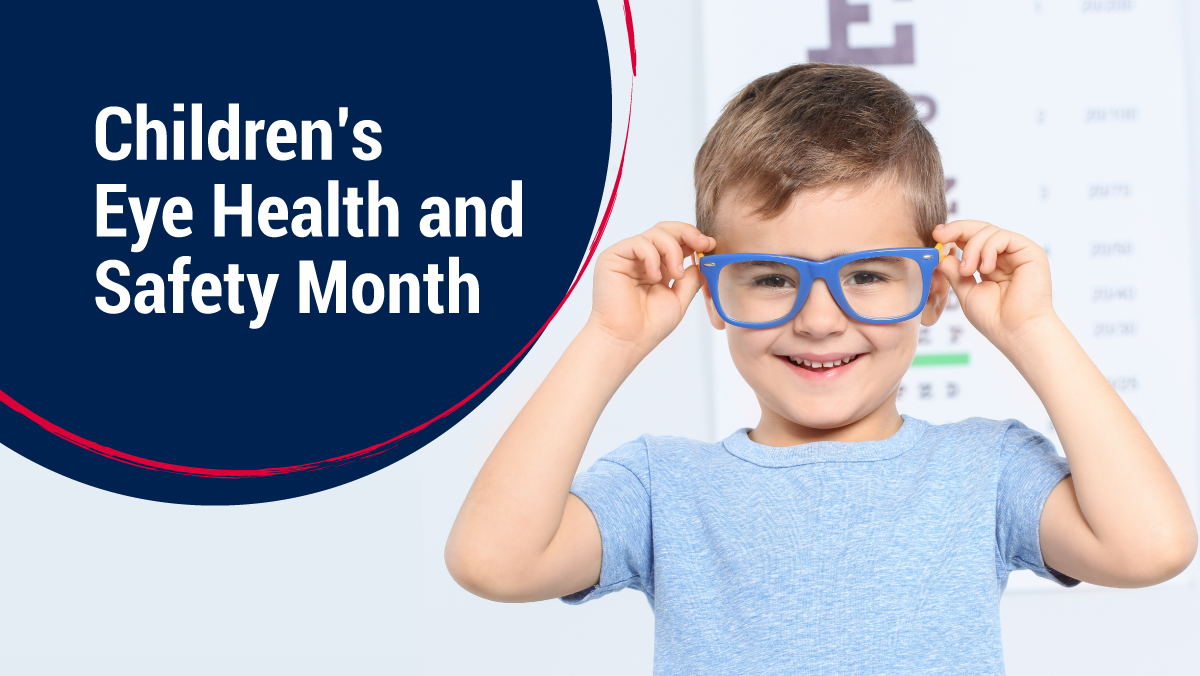
August is Children’s Eye Health and Safety Month! Celebrate by educating yourself on the importance of healthy vision, signs of vision problems in children, and ways to prevent eye injuries.
The Importance of Healthy Eyes
Even after birth, a baby’s eyes haven’t fully developed. Over time, vision centers in the brain develop, and vision improves. If infants aren’t able to use their eyes for whatever reason, visions centers don’t develop properly, and vision is impaired despite their healthy appearance.
Amblyopia, or “lazy eye,” occurs when nerve pathways from one eye to the brain aren’t stimulated. Poor development minimizes the brain’s ability to process images from the affected eye and starts to rely more on the other eye. Without proper signaling, muscles of the amblyopic eye weaken over time and cause the characteristic inward- or outward-wandering of a “lazy eye.” Amblyopia is the most common vision problem in children. If left untreated, amblyopia can cause vision impairment and blindness. Fortunately, amblyopia is usually very treatable, especially when detected early.
Children with vision problems often struggle in the classroom. One study in the journal Optometry and Vision Science found that farsighted preschoolers have a harder time paying attention in school compared to students with normal or corrected vision.
Learning disabilities account for nearly half of all special-needs children. Of those, 75% have difficulty reading, and at least 20% have a clinically significant vision problem. However, visual acuity is just one of the 17 required vision skills for academic success. Your child’s social life, self-esteem, and athletic ability rely on multiple vision abilities, such as good depth perception, peripheral vision, and visual-motor skills.
Your child may not know they have vision problems. Be proactive by monitoring signs of vision problems and scheduling regular exams.
When to Get an Exam
Vision screenings can reveal common sight problems such as near- or farsightedness, but a comprehensive eye exam is necessary to assess possible disease or abnormalities. The American Academy of Ophthalmology recommends the following exams:
1. Newborn
Your child’s first eye exam should happen between three to five days after birth. The primary purpose of an exam at this age is to detect any genetic or developmental abnormalities. Evaluations should assess pupil size and color, the appearance of the eye and eyelid, eye movement, and red reflex.
2. Infant
Similar to a newborn exam, the primary purpose of an infant eye exam is to monitor development progression. During this visit, your child’s pediatrician should examine the response to light, the ability to follow a target, and eye alignment.
3. Preschooler
The third eye exam should occur around age three. Your pediatrician will perform the same tests used for an infant, as well as tests for visual acuity and color blindness. Because children are typically unable to read at this age, visual acuity is often measured using the “tumbling E” chart, in which your child uses three fingers to indicate the direction of a series of different sized “E’s” presented in varying orientations.
4. School Age
By this point, your child should be evaluated for near- and farsightedness. Seek out the help of an ophthalmologist if alignment or other eye health issues exist. Exams should be performed every two years if vision correction isn’t required.
Your child may develop vision problems without realizing it. Keep an eye out for these common warning signs of vision problems:
- Tilting the head or squinting while watching TV or trying to read.
- Frequent eye rubbing when trying to concentrate.
- Holding a book too close or sitting close to the TV.
- Sensitivity to light.
- Using a finger to guide while reading.
- Eye discomfort while using a digital device.
- Excessive blinking.
Importance of Eye Safety
In addition to monitoring vision, protect your child’s eyes from injury by ensuring toys are age-appropriate, baby-proofing the house, and providing sport-related eyewear. According to the most recent U.S. Consumer Product Safety Commission (CPSC) report, there were 226,100 toy-related, emergency department-treated injuries in 2018. However, 97% of toy injuries don’t require an ER visit. Nevertheless, keep your kids safe by:
- Avoiding toys with sharp, protruding, or projectile parts.
- Checking playgrounds for potential eye hazards.
- Keeping children away from fireworks.
- Ensuring toys and home-playground equipment is properly put together.
- Making sure sharp edges of furnishings and fixtures are covered.
- Installing baby gates or guardrails to keep children from wandering into dangerous areas.
- Buying the appropriate sport-related protective eyewear.
Eye injuries can be severe and lead to permanent blindness. If an injury does occur, be sure your child doesn’t touch or rub their eye and seek medical attention right away.
Final Thoughts from USHEALTH Group
Eye health and safety are essential to your child’s growth. As a parent or caregiver, it’s your responsibility to know how to keep your child’s eyes healthy and safe. Schedule regular eye exams, maintain a safe environment, spread awareness, and educate others on the importance of children’s eye health and safety.
Subscribe to our blog to learn more about healthy living.
USHA-WB5-0820